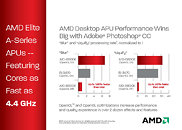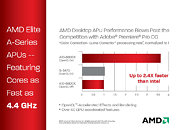- Joined
- Oct 9, 2007
- Messages
- 47,635 (7.44/day)
- Location
- Dublin, Ireland
| System Name | RBMK-1000 |
|---|---|
| Processor | AMD Ryzen 7 5700G |
| Motherboard | Gigabyte B550 AORUS Elite V2 |
| Cooling | DeepCool Gammax L240 V2 |
| Memory | 2x 16GB DDR4-3200 |
| Video Card(s) | Galax RTX 4070 Ti EX |
| Storage | Samsung 990 1TB |
| Display(s) | BenQ 1440p 60 Hz 27-inch |
| Case | Corsair Carbide 100R |
| Audio Device(s) | ASUS SupremeFX S1220A |
| Power Supply | Cooler Master MWE Gold 650W |
| Mouse | ASUS ROG Strix Impact |
| Keyboard | Gamdias Hermes E2 |
| Software | Windows 11 Pro |
After a successful collaboration with AMD over the past two years to leverage open standards to drive amazing quality, scalability, and performance for our customers - Adobe has just released Adobe Photoshop CC and Adobe Premiere Pro CC. Now users can get the production releases of these flagship products which have been optimized to the massive compute power of AMD APUs, AMD Radeon HD graphics and AMD FirePro professional graphics to enable GPU-accelerated performance across a broad range of form factors through the OpenGL and OpenCL open standards. As highlighted in recent blogs, these optimizations are significant because, not only do they result in faster final render times, but more importantly, they enable users to apply effects and preview their edits in real-time, enabling greater productivity. This is great news for end-users everywhere, who now have unprecedented choice in using the hardware that best suits their needs. AMD-based systems coupled with Adobe's shift to the affordable and innovative Adobe Creative Cloud model for managing licenses and software updates can now put these latest Adobe creative tools in the hands of more users than ever.


When researching options for upcoming hardware purchases, consumers often look online for recommendations from top reviewers. Both Adobe Photoshop and Premiere Pro are often used by such reviewers to benchmark the capabilities of PC hardware because they are good examples of widely used, compute-intensive, non-gaming applications. These two applications are also good indicators of the direction that the mainstream software ecosystem is going relative to the use of both CPU and GPU resources in computers systems; i.e. - heterogeneous compute. We expect to see even greater adoption of this approach as the tools and system architecture evolve with our Heterogeneous System Architecture (HSA) initiative. The bottom line - products that can best handle Adobe Premiere Pro and Adobe Photoshop are going to be great all-around compute machines for consumers in general.
Delivered performance is always dependent on both hardware and software performance even the fastest hardware in the world can become crippled when coupled with a faulty or low-performing video drivers or with an application that does not efficiently leverage the hardware resources. The great news is that with AMD and Adobe, you get all three of these critical components. We tested the production builds for both Adobe Photoshop CC and Adobe Premiere Pro CC with the latest publically available drivers, converted the raw times into rates, and normalized to 1 (where "1" is the slowest of the test scenarios to complete the test) to make the charts and comparison easier to read. The results below* are for our newest AMD Elite A-series APU - the AMD A10-6800K.
AMD has worked closely with Adobe not only on the development side to enable optimized application performance on AMD hardware, but also on the quality assurance (QA) side to support the rigorous testing Adobe requires to achieve "White List" status with every Premiere Pro release (see Adobe blog post and tech specs). In fact, AMD can currently boast the greatest number of products on Adobe's officially qualified hardware list - a total of 64 graphics devices today with even more expected over time. While acceleration on Premiere Pro can be enabled by end users for any OpenCL-capable device in a PC or Mac, the fact that Adobe has included so many officially qualified AMD devices on the list is a testament to the hard work and close collaboration between AMD and Adobe; we are pleased to have made the effort with Adobe to enable this added level of assurance and to deliver a top-notch user experience for our shared customers.
View at TechPowerUp Main Site


When researching options for upcoming hardware purchases, consumers often look online for recommendations from top reviewers. Both Adobe Photoshop and Premiere Pro are often used by such reviewers to benchmark the capabilities of PC hardware because they are good examples of widely used, compute-intensive, non-gaming applications. These two applications are also good indicators of the direction that the mainstream software ecosystem is going relative to the use of both CPU and GPU resources in computers systems; i.e. - heterogeneous compute. We expect to see even greater adoption of this approach as the tools and system architecture evolve with our Heterogeneous System Architecture (HSA) initiative. The bottom line - products that can best handle Adobe Premiere Pro and Adobe Photoshop are going to be great all-around compute machines for consumers in general.
Delivered performance is always dependent on both hardware and software performance even the fastest hardware in the world can become crippled when coupled with a faulty or low-performing video drivers or with an application that does not efficiently leverage the hardware resources. The great news is that with AMD and Adobe, you get all three of these critical components. We tested the production builds for both Adobe Photoshop CC and Adobe Premiere Pro CC with the latest publically available drivers, converted the raw times into rates, and normalized to 1 (where "1" is the slowest of the test scenarios to complete the test) to make the charts and comparison easier to read. The results below* are for our newest AMD Elite A-series APU - the AMD A10-6800K.
AMD has worked closely with Adobe not only on the development side to enable optimized application performance on AMD hardware, but also on the quality assurance (QA) side to support the rigorous testing Adobe requires to achieve "White List" status with every Premiere Pro release (see Adobe blog post and tech specs). In fact, AMD can currently boast the greatest number of products on Adobe's officially qualified hardware list - a total of 64 graphics devices today with even more expected over time. While acceleration on Premiere Pro can be enabled by end users for any OpenCL-capable device in a PC or Mac, the fact that Adobe has included so many officially qualified AMD devices on the list is a testament to the hard work and close collaboration between AMD and Adobe; we are pleased to have made the effort with Adobe to enable this added level of assurance and to deliver a top-notch user experience for our shared customers.
View at TechPowerUp Main Site









